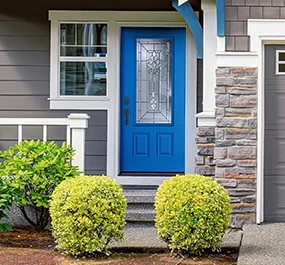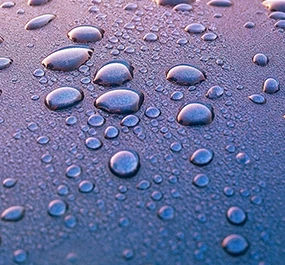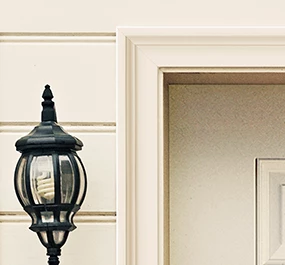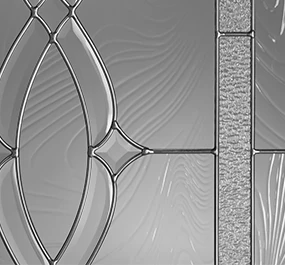The kind of door that complements a house is directly informed by the structure’s specific exterior architectural style, which helps guide homeowners to the correct front door styles. Fiberglass doors offer versatility that other materials aren’t able to match. This makes the wide variety of fiberglass doors available through Plastpro a great option regardless of your home’s established architectural influences.
All those possible combinations mean that choosing the right door for your home may be a difficult proposition—difficult, but not impossible. Finding the right inspiration will lead to finding the perfect door. You just need to know the architectural style you seek. Let’s dive into understanding this important concept.
Understanding Your Home’s Architectural Style
If you want to choose the best front door for your home, it’s important for your door to match the home’s outdoor architectural style over anything else. Your home’s outdoor features, its porch area, and its main exterior door work together to create a uniform presentation. Usually, it becomes the first impression visitors and passersby get from your home, so be sure to consider the importance of curb appeal. You’ll gain that curb appeal through an eye toward the sort of door that’ll mesh well with your home’s stylistic features.
Those features are most likely drawn from a few architectural styles that prevailed in America during home-building booms like the one seen shortly after World War II.
The traditional architectural style is one of the most consistently popular styles in the United States. These homes feature symmetrical window placement, shy away from overly ornate details, and are topped by roofs that are more functional than form. Traditional front doors should blend into the established traditional look with subdued features while reflecting the staying power of this beloved style.
Homes sporting the craftsman style stand as celebrations of what people can build with their ingenuity. This architectural style pushes the handmade aesthetic to the forefront while utilizing materials that are natural—or look the part—to give the home a DIY arts and crafts style look. The inspiration for this approach came from the most unlikely of places: the mass manufacturing potential of the British Industrial Revolution.
As a response to the rise of industry, people there began a grassroots arts and crafts movement that influenced the homebuilders of 20th-century America. Craftsman homes are best complemented by doors made with natural looking materials that feature glass inserts.
Modern homes are characterized as such due to their adherence to an of-the-time aesthetic featuring lots of flat, open exterior walls that contribute to an angular look. Colors trend darker, materials usually lack texture and any exterior decorations are usually limited to subtle recessed or in-the-ground light fixtures. Doors for this sort of style trend are uniform in both color and design—no panels and one uniform color. Any glass inserts are usually singular and run vertically.
The rustic approach brings in natural-looking features that reflect resources available in the environment that surrounds the home. Rustic homes can sometimes be made from a combination of materials, so it’s usually best to look to a home’s exterior trim and slight decorative features to draw inspiration for a door. There are options here—if you’re going for a more natural look, don’t be afraid to choose glass and let some light in. However, if you’re leaning more towards texture and large features, a wood-looking slab door with a lot of texture and accessories like clavos may be best.
Should Your Front Door Match Your Interior Doors?
There’s no rule stating your front door needs to match your interior doors. The majority of people who see the exterior of your home will never see its interior. When you’re looking for inspiration on a new entry door, put more emphasis on matching your front door to the colors and features that adorn your home’s outside walls and surrounding property. It should be noted that you’ll also want to look at your neighborhood’s HOA guidelines, if applicable.
With that said, there’s a reason homeowners strive to match their front doors to the rest of their property. If the outside of your home informs its inside, it’ll be more welcoming and impressive for guests making that outdoor-indoor transition.
You can use any aspect of your home’s outdoor appearance to tie it into your indoor space. For example, rustic homeowners tend to do a great job keeping that architectural style going with great interior design choices. Sure, it helps that repurposed and reclaimed décor is in fashion right now, but thinking about how that style can be pervasive throughout a home may help you picture how your outdoor look can make its way inside. If you’re going to use the front door to inspire other interior door choices, remember that something as small as a repeated feature could be enough to create that connection.
Matching Door Designs with Traditional Homes
We briefly discussed the traditional architectural style and traditional front doors, but the truth is that choosing a door for this style of home presents a wide range of options.
First, consider what the exterior of your traditional style home is telling you. If your front façade presents many symmetrical windows, you may want to dial back your use of paneling and glass inserts. If the area surrounding the front door is relatively devoid of windows, panels and inserts are a great way to add variety while making your door stand out. Plastpro’s Mahogany Series, Oak Series, and White Oak Series all feature timeless looks and multiple panel patterns. Glass inserts are also possible, making them incredibly versatile fiberglass door options.
Next, consider what your wants for your front door are telling you. If your main consideration is color, fiberglass doors can be painted or stained the same as any other material. If you’d like to add accessories to the door, fiberglass doors can be outfitted with those, too.
However, one of the main disadvantages of fiberglass doors is that you are dealing with glass, so protective eyewear, gloves, and a mask are musts. You should wear protective wear when working with any door, though—splinters and pieces of metal can be just as dangerous.
When you put thought into the front door replacement, you’ll get an exterior door that serves the needs of both you and your traditional home’s style.
Choosing Contemporary Front Doors
The boldness of a contemporary style home deserves a striking door to match. Modern and contemporary go hand-in-hand when talking about the design of a door, so you’re looking at clean, simple lines that create angular designs, singular glass inserts, and minimalist accessories like handles instead of knobs.
Plastpro’s Modern Series provides homeowners with options for contemporary front doors that perfectly complement their home’s entryway. Plus, the use of fiberglass is a great modern addition that’ll help the home maintain a desired indoor temperature—something that modern homes may have issues with due to their generous use of glass.
Adapting Transitional Door Styles
Transitional doors are a great way to blend classic looks with contemporary features. This style of door is often used with older architectural styles to add a touch of modernity, such as glass inserts being used in place of panels in a traditional style door, or sleek modern hardware affixed to an otherwise traditional slab door.
The aforementioned White Oak Series of doors from Plastpro does a great job presenting a base for bridging the old and new. Its standout color is much bolder than doors seen on most classic-style homes, and it's ripe for customization. In this case, the Limited Series is useful for similar reasons.
Selecting the Right Color and Finish
The color of a door may be just as important as its design and accessories.
Color can be ascertained in several ways. You could go with what you like whether it matches your home’s exterior aesthetic or not, but if you want to strive for some sort of uniform presentation or maintain curb appeal, there are guidelines. Also, if you have a pink house and you paint your door lime green, the kind of attention that’ll draw isn’t really what we’re aiming for—curb appeal is considered positive attention.
One way to choose a color or finish is by paying attention to the subtle details of your home’s exterior. You can match a door to trim, ornate details, or any colored or finished feature that shows up sporadically, tying your outdoor presentation together. If the outside of your home presents a prevailing color or is monochrome, you can use your door to mix things up. Usually, homeowners choose to go three shades lighter or darker than the color in question.
If you are choosing a finish over a color, the shade rule can still apply if you’d like a reliable way to create some contrast. However, matching the look to other wooden features in your home is usually a cleaner way to create cohesion.
Using paint or finish to change your existing front door won’t just alter its aesthetic features—it’s also a great way to refresh a door and extend its lifespan.
Contemporary, Traditional, and More Front Doors from Plastpro
Matching a door to your home’s architectural style isn’t always easy, but choosing the right kind of door with the right color or finish creates a pleasing result that boosts curb appeal and makes your home feel more welcoming. When you’re taking on this task, remember to look to your home’s built-in hints to help you find the right answers—and don’t forget to ask yourself what you think is important in a new door, too.
If safety, durability, and sustainability are on that list, fiberglass doors are the best option for you. Plastpro’s doors have those features covered while additionally offering a wide range of cosmetic options for any architectural style. Find a dealer and begin building your dream entryway today!



